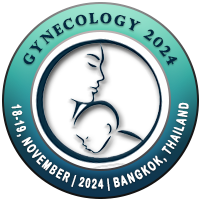
Belardo María Alejandra
Italian Hospital Buenos Aires , ArgentinaTitle: Hormone Replacement Therapy in Oncological High Risk Patients: Is It Possible?
Abstract
BRCA 1 mutation - BRCA 2 mutation -
risk reducing salpingo ophorectomy - menopausal symptoms - replacement hormone therapy - hot flashes - vasomotor
symptoms-osteoporosis.
Hormone replacement therapy (HRT) has been prescribed
for women to ameliorate menopausal symptoms, in particular, hot flashes and
night sweats, and in addition, to prevent other aging-related conditions, including
osteoporosis and cardiovascular disease. Contraindications to HRT include
hormone dependent cancers, especially breast cancer. Related to this issue,
there is a subgroup of oncological high risk women who are carriers of a
pathogenic variant of the BRCA1/2 gene (mBRCA) These women have a higher
lifetime risk of developing ovarian cancer (OC) and breast cancer (BC). A
germline mutation in BRCA1 or BRCA2 results in a significantly elevated
lifetime risk of developing breast cancer (BC) and ovarian cancer (OC). Indeed,
more than 90% of hereditary cases of BC and OC are thought to be a result of a
mutation in BRCA1/2. Patients with BRCA1 mutations, cumulative risk of BC and
OC by age 80 is about 72% and 44% respectively; for BRCA2 mutations, that risk
is about 69% and 17% respectively. Therefore, the NCCN Guidelines Panel
recommends risk-reducing salpingo oophorectomy (RRSO) for women with a known
BRCA1/2 mutation, between the ages of 35 and 40 with a BRCA1 mutation, and
between 40 and 45 years of age in women with a BRCA2 mutation, since ovarian
cancer onset tends to be later in this group. RRSO is associated with an OC
risk-reduction of approximately 80% and it also seems to reduce BC risk by
approximately 50%. Despite of the well-established reduction in cancer risk,
oophorectomy induces surgical menopause and its associated risks. Studies have
shown that in the general population, women who underwent RRSO before age 45
had an increased mortality associated with cardiovascular disease (CV) compared
to women who had not undergone any oophorectomy. Women who were not treated
with estrogen after RRSO until at least age 45 had significantly higher
mortality due to CV disease; women treated with estrogen after RRSO were not
statistically different than women not undergoing RRSO. Therefore, for CV
disease the cut-off age would appear to be 45 years. In Regard to cognitive
dysfunction and dementia, studies have reported oophorectomy to be associated
with a greater risk in women who undergo this surgery at a younger age than 48
years and that bilateral oophorectomy before menopause had an increased risk of
cognitive impairment or dementia compared to those without oophorectomy. The
risk was higher for women undergoing RRSO before age 49 that were not treated
with estrogen until age 50. The fear of BC risk by physicians and patients is
the biggest determinant when prescribing HRT. Data shows that HRT mitigates
menopausal symptoms in women with a known mBRCA who have undergone RRSO.
Clinical practice guidelines also validate the use of HRT in mBRCA after RRSO.
ESMO Clinical practice guidelines and NCCN established that short-term HRT in
women undergoing RRSO does not counter the reduction in BC risk associated with
the surgery. Indeed, the Canadian, Dutch, United States of America (USA),
United Kingdom (UK), Australian and Argentine guidelines have stated that HRT
can be offered after RRSO for a short period of time in premenopausal women
without a history of breast cancer until the age of natural menopause. The NAMS
(North American Menopause Society) affirms that, even though the studies that
have addressed the effect of HRT use by patients are limited by their
observational design, size, and limited duration of follow-up, they provide
some reassurance for clinicians and patients that use of systemic HRT does not
substantially increase breast cancer risk

